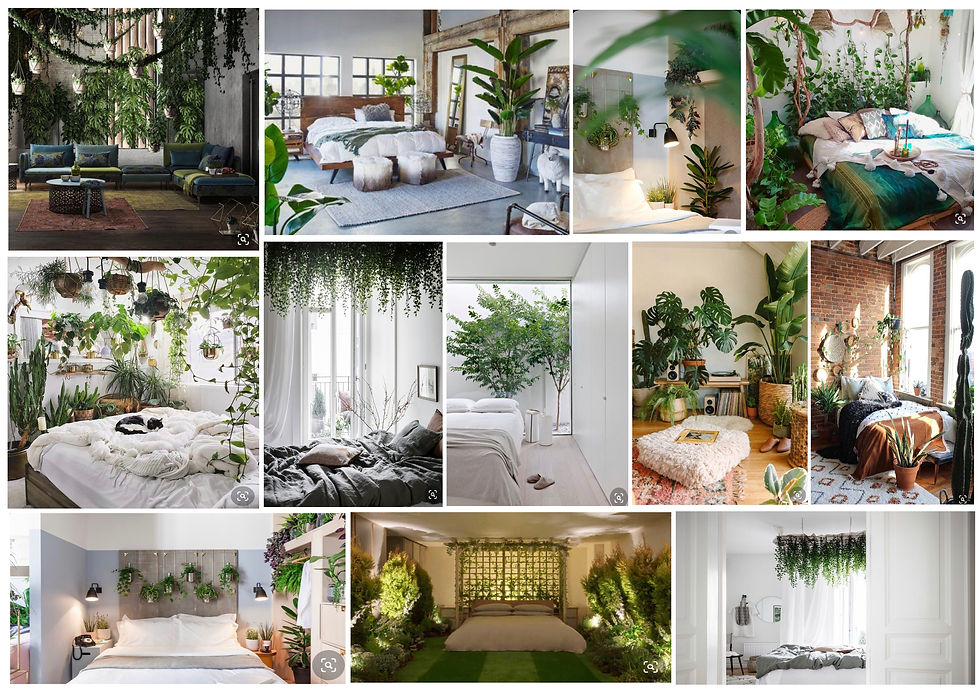Biophilic Outcome - Installation Mind-map & Mood-boards...
- imogenwest98
- Nov 24, 2020
- 3 min read
Updated: Jan 17, 2021
"The biophilic experiences are more likely to persist long term when they are embedded in the programming and infrastructure of a place." - Terrapin's '14 Patterns of Biophilic Design'. Having spent time visualising and sketching out various biophilic elements, that can be seen on my other blog posts, I have began refining potential ideas for an outcome. Producing sketches, line drawings and using various medias for the 50-postcard activity allowed me to develop my understanding of what biophilia can entail, and what plants and flowers specifically are beneficial to us in different ways. Having created a further brainstorm and additional mood-boards to help with my decision making, I have decided to point my project in the direction of producing an installation. Producing a large-scale installation is a slightly looming idea as i have never produced one before, however I do feel as though it is the most appropriate outcome that will allow me to really discover and showcase the intricate details and benefits of biophilic design - not something that can be necessarily be replicated through the likes of a 2D drawing. Below is a mind-map to show my thought processes where initially considering an installation;

Below is a mood-board of various interior installations that either I admired or inspired me. As can be seen within the images, an installation can be sculpted from the walls, the cieling, the floor or even as a piece in the centre of the room - where refining a potential environment, i need to consider what would be the most practical option.

In the bedroom... Here is a further mood-board I have made solely focusing on biophilic design within the bedroom. Having analysed and sketched out (on a previous blog post) the features of various plants that are beneficial to different rooms within the home, many, such as lavender, help us fall into a deep sleep, just by having it near us. Where developing my project, I will continue to analyse what plants are most appropriate where, and will evidently apply this to my eventual design.

Where we eat... A lot of biophilic design is incorporated within the kitchen, more recently than ever. Evidently, having plants anywhere within our home or workplace is hugely efficient where increasing air flow and purity - but kitchen designs today include a lot of biophilic design elements that cant initially be seen, such as steam ovens and filter taps. I have intentionally included images of biophilic design within canteens and larger seating areas to showcase one way biophilia is incorporated within popular public areas.

Why not where we sleep, eat, rest and recover?... It can be understandable as to how including biophilic design within the likes of hospital patient rooms might be difficult, however the physical and mental health benefits biophilic design can bring to those who are recovering is both extremely interesting and impressive. The images within the mood-board below show how bleak, boring and dull hospital rooms can be, and most are. Including photographs and prints of the natural world within hospital rooms is certainly an approach taken, as can be seen in just a few of the images here, but it brings no benefits other than mere visual pleasure. "Health benefits are suggested to include reductions in stress, boredom, irritation, fatigue and perceived vulnerability, as well as improved comfort." - All major symptoms amongst hospital patients.
"Patients within hospitals and other medical locations that have incorporated the natural environment into the facility’s design have been found to have substantial healing benefits. This is because simple inclusions of nature, or interpretations of it, aid in the healing process of patients."
As mentioned on my initial research blog post where referencing Oliver Heath's interior design, biophilic design within our healthcare systmes has been proven to reduce stress, reduce post-operative recovery times by 8% and the need for pain medication reduced by 22%. These significant facts and statistics are what have pushed me towards looking further into biophilic design within hospitals.



Comments